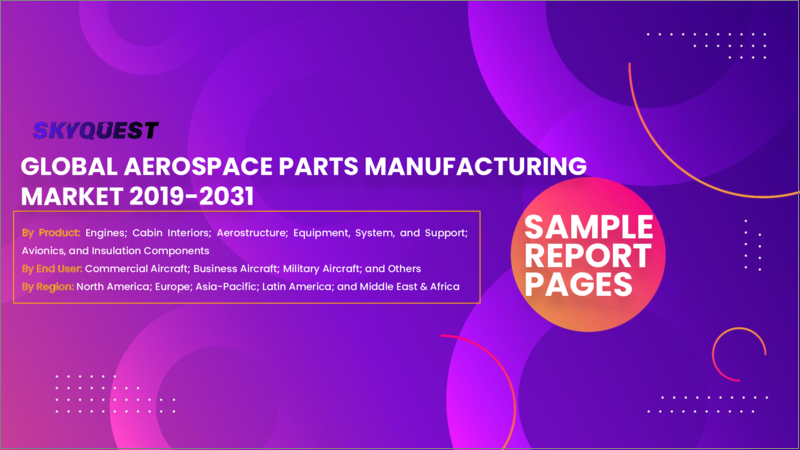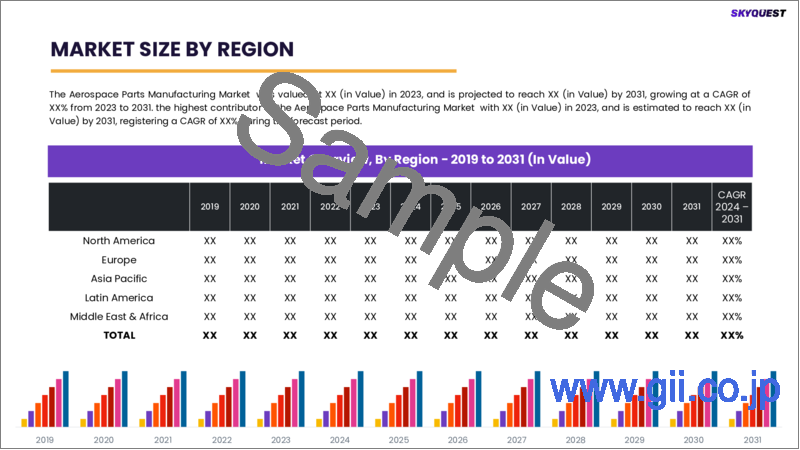|
|
市場調査レポート
商品コード
1427144
航空宇宙部品製造の世界市場規模、シェア、成長分析、製品タイプ別- 産業予測、2023~2030年Global Aerospace Parts Manufacturing Market Size, Share, Growth Analysis, By Product(Engines, Aircraft Manufacturing), By Type(Commercial, Business) - Industry Forecast 2023-2030 |
||||||
| 航空宇宙部品製造の世界市場規模、シェア、成長分析、製品タイプ別- 産業予測、2023~2030年 |
|
出版日: 2024年02月03日
発行: SkyQuest
ページ情報: 英文 157 Pages
納期: 3~5営業日
|
- 全表示
- 概要
- 目次
航空宇宙部品製造の世界市場規模は、2022年に8,985億8,000万米ドルと評価され、予測期間(2024-2031年)のCAGRは4.1%で、2023年の9,354億2,000万米ドルから2031年には1兆2,900億7,000万米ドルに成長する見通しです。
航空宇宙部品の製造は、航空宇宙部品の複雑さを考えると、高い管理コストと厳しい品質基準を伴う。航空宇宙産業は、統合された活発なバリューチェーンの中で運営されており、多数の航空機製造事業体が全領域にわたって関与しています。これらの企業は、サプライヤーとの契約や社内の生産設備を通じて部品を確保することが多く、調達と外部の原材料サプライヤーの両方が提供する品質管理プロセスに積極的に参加しています。航空機は、およそ20年から30年の間、信頼できる資産として機能するが、メンテナンスや運用に関連するコストが高騰し、生み出される収益を上回るため、買い替えが必要になります。新しい航空機や航空宇宙部品は、航続距離や積載量の向上といった利点をもたらし、燃料効率の改善、大幅なコスト削減、利益率の向上につながります。航空業界の代替率は毎年約3%に達し、航空機の代替は新しい航空宇宙部品の生産における持続的な需要の重要な基盤を形成しています。航空宇宙部門は、旅客のダイナミックな需要に応えるために絶え間ない進化を遂げており、新しい飛行機や空港インフラの開発が必要とされています。この適応は、旅行の快適性、スピード、豪華さを向上させながら、乗客数の増加に対応することを目的としています。航空宇宙産業は、消費者の高いサービス需要に後押しされ、安全でより良い旅行体験を保証するために、新しい付属品やサービスを搭載した航空機を継続的に改良しています。これを達成するためには、既存の航空機をアップグレードするか、新しい航空機を開発する必要があり、それによって航空宇宙部品製造業界は、現代の乗客の進化するニーズに応えるために多様な部品を製造するようになります。
世界の航空宇宙部品製造市場の規模を推定・検証し、その他の様々な依存サブマーケットの規模を推定するために、トップダウンアプローチとボトムアップアプローチを使用しました。市場規模を推定するために使用した調査手法には、以下の詳細が含まれる:2次調査を通じて市場の主要企業を特定し、1次調査と2次調査を通じて各地域における市場シェアを決定しました。この全手順には、主要企業の年次報告書および財務報告書の調査、CEO、副社長、取締役、マーケティング担当役員などの業界リーダーからの重要な洞察を得るための広範なインタビューが含まれます。シェアの割合や内訳はすべて二次情報を用いて決定し、一次情報によって検証しました。本調査の対象となる市場に影響を与える可能性のあるパラメータはすべて考慮され、広範かつ詳細に検討され、1次調査を通じて検証され、最終的な定量的・定性的データを得るために分析されました。
航空宇宙部品製造の世界市場セグメント別分析
航空宇宙部品製造の世界市場は、製品、タイプ、地域によって区分されます。製品別では、市場はエンジン、航空機製造、断熱部品製造に区分されます。タイプ別では、市場は商業、ビジネス、軍事に区分されます。地域別では、北米、欧州、アジア太平洋、中東・アフリカ、ラテンアメリカに区分されます。
世界の航空宇宙部品製造市場の促進要因
世界各国政府は、先進的な軍用機、ミサイル、防衛システムの調達を通じて軍事力を強化することを目的とした防衛近代化プログラムに多額の資金を割り当てています。この投資は航空宇宙部品製造市場に勢いを注入し、防衛装備品の生産に不可欠な重要部品を供給しています。
NASAのような政府機関や非公開会社が主導する宇宙開発構想の急増は、特殊な航空宇宙部品やコンポーネントに対する需要の高まりに拍車をかけています。これらには推進システム、衛星部品、宇宙船構造が含まれ、航空宇宙部品製造セクターの成長を牽引しています。
世界の航空宇宙部品製造市場における抑制要因
航空宇宙部品の認証・承認プロセスは複雑で時間がかかります。製造業者は、自社の部品が必要な規格や仕様に適合していることを保証するために、厳格な試験、検証、確認の手順を経なければならないです。認証取得に遅れが生じると、生産スケジュールに支障をきたし、市場競争力に悪影響を及ぼす可能性があります。
世界の航空宇宙部品製造市場の動向
一般に3Dプリンティングと呼ばれる積層造形は、航空宇宙産業、特に部品製造に革命的な変革をもたらしつつあります。この最先端技術により、複雑で軽量な個別化部品の作成が可能になり、材料の無駄が大幅に削減されます。積層造形は、比類のない設計の柔軟性、リードタイムの短縮、オンデマンド生産の見通しを提供します。航空宇宙部品メーカーは、効率を高め、コストを下げ、全体的な性能を高めるために、こうした革新的な技術を徐々に取り入れています。
目次
- エグゼクティブサマリー
- 調査手法
- 親市場の分析
- 主な市場の考察
- 技術分析
- 価格分析
- サプライチェーン分析
- バリューチェーン分析
- 市場のエコシステム
- IP分析
- 貿易分析
- スタートアップ分析
- 原材料の分析
- イノベーションマトリクス
- パイプライン製品の分析
- マクロ経済指標
- 主な投資の分析
- 主な成功要因
- 競合の度合い
- 市場力学と見通し
- 市場力学
- 促進要因
- 機会
- 抑制要因
- 課題
- 規制情勢
- ポーターの分析
- 将来の混乱についての特別な考察
- 市場力学
- 航空宇宙部品製造の世界市場:製品別
- 市場概要
- エンジン
- 航空機製造
- 断熱部品の製造
- 航空宇宙部品製造の世界市場:タイプ別
- 市場概要
- 商業用
- ビジネス
- 軍用
- 航空宇宙部品製造の世界市場規模:地域別
- 市場概要
- 北米
- 米国
- カナダ
- 欧州
- ドイツ
- スペイン
- フランス
- 英国
- その他欧州地域
- アジア太平洋
- 中国
- インド
- 日本
- 韓国
- その他アジア太平洋地域
- ラテンアメリカ
- ブラジル
- その他ラテンアメリカ地域
- 中東・アフリカ(MEA)
- GCC諸国
- 南アフリカ
- その他中東・アフリカ地域
- 競合情勢
- 上位5社の比較
- 主要企業の市場ポジショニング(2021年)
- 主な市場企業が採用した戦略
- 主要成功戦略
- 市場における最近の活動
- 主要企業の市場シェア(2021年)
- 主要企業プロファイル
- Airbus(France)
- Boeing(United States)
- General Electric(United States)
- Safran(France)
- Rolls-Royce Holdings(United Kingdom)
- Lockheed Martin(United States)
- United Technologies Corporation(United States)
- Honeywell International(United States)
- Leonardo S.p.A.(Italy)
- Northrop Grumman Corporation(United States)
- Raytheon Technologies Corporation(United States)
- Thales Group(France)
- BAE Systems(United Kingdom)
- Spirit AeroSystems(United States)
- Bombardier(Canada)
- Mitsubishi Heavy Industries(Japan)
- Kawasaki Heavy Industries(Japan)
- Embraer(Brazil)
- Saab AB(Sweden)
- Pratt & Whitney(United States)
- Zodiac Aerospace(France)
- Textron Inc.(United States)
Global Aerospace Parts Manufacturing Market size was valued at USD 898.58 Billion in 2022 and is poised to grow from USD 935.42 Billion in 2023 to USD 1290.07 Billion by 2031, at a CAGR of 4.1% during the forecast period (2024-2031).
The manufacturing of aerospace parts involves elevated administrative costs and stringent quality standards, given the intricacies of aerospace components. The aerospace industry operates within an integrated and active value chain, with numerous aircraft manufacturing entities engaged across the entire spectrum. These entities often secure parts through supplier agreements and internal production facilities, actively participating in quality control processes provided by both procurement and external raw material suppliers. Aircraft, serving as dependable assets for approximately two to three decades, necessitate replacement due to the escalating costs associated with maintenance and operation outweighing generated revenue. Newer aircraft and aerospace components present advantages such as enhanced range and payload capacity, leading to improved fuel efficiency, substantial cost savings, and increased profit margins. The industry replacement rate for airlines stands at approximately 3% annually, with fleet replacement forming a crucial foundation for sustained demand in the production of new aerospace components. The aerospace sector undergoes constant evolution to meet the dynamic demands of passengers, necessitating the development of new planes and airport infrastructure. This adaptation aims to accommodate the growing number of passengers while enhancing travel comfort, speed, and luxury. The aerospace industry, driven by high service consumer demands, continuously enhances aircraft with new accessories and services to ensure a safe and improved travel experience. Achieving this involves either upgrading existing aircraft or developing new ones, thereby propelling the aerospace parts manufacturing industry as it produces a diverse range of components to meet the evolving needs of modern passengers.
Top-down and bottom-up approaches were used to estimate and validate the size of the Global Aerospace Parts Manufacturing Market and to estimate the size of various other dependent submarkets. The research methodology used to estimate the market size includes the following details: The key players in the market were identified through secondary research, and their market shares in the respective regions were determined through primary and secondary research. This entire procedure includes the study of the annual and financial reports of the top market players and extensive interviews for key insights from industry leaders such as CEOs, VPs, directors, and marketing executives. All percentage shares split, and breakdowns were determined using secondary sources and verified through Primary sources. All possible parameters that affect the markets covered in this research study have been accounted for, viewed in extensive detail, verified through primary research, and analysed to get the final quantitative and qualitative data.
Global Aerospace Parts Manufacturing Market Segmental Analysis
Global Aerospace Parts Manufacturing Market is segmented on the basis of product, type and region. By product, the market is segmented into engines, aircraft manufacturing, insulation components manufacturing. By type, market is segmented into commercial, business, military. By region, the market is segmented into North America, Europe, Asia Pacific, Middle East and Africa, and Latin America.
Drivers of the Global Aerospace Parts Manufacturing Market
Governments worldwide are allocating substantial funds towards defense modernization programs, aimed at bolstering military capabilities through the procurement of advanced military aircraft, missiles, and defense systems. This investment injects momentum into the aerospace parts manufacturing market, supplying critical components essential for defense equipment production.
The surge in space exploration initiatives, led by government agencies like NASA and private space companies, has spurred a heightened demand for specialized aerospace parts and components. These include propulsion systems, satellite components, and spacecraft structures, driving growth in the aerospace parts manufacturing sector.
Restraints in the Global Aerospace Parts Manufacturing Market
The certification and approval processes for aerospace parts are intricate and time-consuming. Manufacturers must navigate rigorous testing, validation, and verification procedures to guarantee that their components adhere to the necessary standards and specifications. Any delays in securing certifications can impede production schedules and adversely affect market competitiveness.
Market Trends of the Global Aerospace Parts Manufacturing Market
Additive manufacturing, commonly referred to as 3D printing, is bringing about a revolutionary transformation in the aerospace industry, particularly in parts manufacturing. This cutting-edge technology enables the creation of intricate, lightweight, and personalized components, significantly minimizing material waste. Additive manufacturing offers unparalleled design flexibility, shorter lead times, and the prospect of on-demand production. Aerospace parts manufacturers are progressively embracing these innovative techniques to elevate efficiency, lower costs, and enhance overall performance.
Table of Contents
- Executive Summary
- Market Overview
- Wheel of Fortune
- Research Methodology
- Information Procurement
- Secondary & Primary Data Sources
- Market Size Estimation
- Market Assumptions & Limitations
- Parent Market Analysis
- Market Overview
- Market Size
- Market Dynamics
- Drivers
- Opportunities
- Restraints
- Challenges
- Key Market Insights
- Technology Analysis
- Pricing Analysis
- Supply Chain Analysis
- Value Chain Analysis
- Ecosystem of the Market
- IP Analysis
- Trade Analysis
- Startup Analysis
- Raw Material Analysis
- Innovation Matrix
- Pipeline Product Analysis
- Macroeconomic Indicators
- Top Investment Analysis
- Key Success Factor
- Degree of Competition
- Market Dynamics & Outlook
- Market Dynamics
- Drivers
- Opportunities
- Restraints
- Challenges
- Regulatory Landscape
- Porters Analysis
- Competitive rivalry
- Threat of Substitute Products
- Bargaining Power of Buyers
- Threat of New Entrants
- Bargaining Power of Suppliers
- Skyquest Special Insights on Future Disruptions
- Political Impact
- Economic Impact
- Social Impact
- Technical Impact
- Environmental Impact
- Legal Impact
- Market Dynamics
- Global Aerospace Parts Manufacturing Market by Product
- Market Overview
- Engines
- Aircraft Manufacturing
- Insulation Components Manufacturing
- Global Aerospace Parts Manufacturing Market by Type
- Market Overview
- Commercial
- Business
- Military
- Global Aerospace Parts Manufacturing Market Size by Region
- Market Overview
- North America
- USA
- Canada
- Europe
- Germany
- Spain
- France
- UK
- Rest of Europe
- Asia Pacific
- China
- India
- Japan
- South Korea
- Rest of Asia-Pacific
- Latin America
- Brazil
- Rest of Latin America
- Middle East & Africa (MEA)
- GCC Countries
- South Africa
- Rest of MEA
- Competitive Landscape
- Top 5 Player Comparison
- Market Positioning of Key Players, 2021
- Strategies Adopted by Key Market Players
- Top Winning Strategies
- By Development
- By Company
- By Year
- Recent Activities in the Market
- Key Companies Market Share (%), 2021
- Key Company Profiles
- Airbus (France)
- Company Overview
- Business Segment Overview
- Financial Updates
- Key Developments
- Boeing (United States)
- Company Overview
- Business Segment Overview
- Financial Updates
- Key Developments
- General Electric (United States)
- Company Overview
- Business Segment Overview
- Financial Updates
- Key Developments
- Safran (France)
- Company Overview
- Business Segment Overview
- Financial Updates
- Key Developments
- Rolls-Royce Holdings (United Kingdom)
- Company Overview
- Business Segment Overview
- Financial Updates
- Key Developments
- Lockheed Martin (United States)
- Company Overview
- Business Segment Overview
- Financial Updates
- Key Developments
- United Technologies Corporation (United States)
- Company Overview
- Business Segment Overview
- Financial Updates
- Key Developments
- Honeywell International (United States)
- Company Overview
- Business Segment Overview
- Financial Updates
- Key Developments
- Leonardo S.p.A. (Italy)
- Company Overview
- Business Segment Overview
- Financial Updates
- Key Developments
- Northrop Grumman Corporation (United States)
- Company Overview
- Business Segment Overview
- Financial Updates
- Key Developments
- Raytheon Technologies Corporation (United States)
- Company Overview
- Business Segment Overview
- Financial Updates
- Key Developments
- Thales Group (France)
- Company Overview
- Business Segment Overview
- Financial Updates
- Key Developments
- BAE Systems (United Kingdom)
- Company Overview
- Business Segment Overview
- Financial Updates
- Key Developments
- Spirit AeroSystems (United States)
- Company Overview
- Business Segment Overview
- Financial Updates
- Key Developments
- Bombardier (Canada)
- Company Overview
- Business Segment Overview
- Financial Updates
- Key Developments
- Mitsubishi Heavy Industries (Japan)
- Company Overview
- Business Segment Overview
- Financial Updates
- Key Developments
- Kawasaki Heavy Industries (Japan)
- Company Overview
- Business Segment Overview
- Financial Updates
- Key Developments
- Embraer (Brazil)
- Company Overview
- Business Segment Overview
- Financial Updates
- Key Developments
- Saab AB (Sweden)
- Company Overview
- Business Segment Overview
- Financial Updates
- Key Developments
- Pratt & Whitney (United States)
- Company Overview
- Business Segment Overview
- Financial Updates
- Key Developments
- Zodiac Aerospace (France)
- Company Overview
- Business Segment Overview
- Financial Updates
- Key Developments
- Textron Inc. (United States)
- Company Overview
- Business Segment Overview
- Financial Updates
- Key Developments
- Airbus (France)




